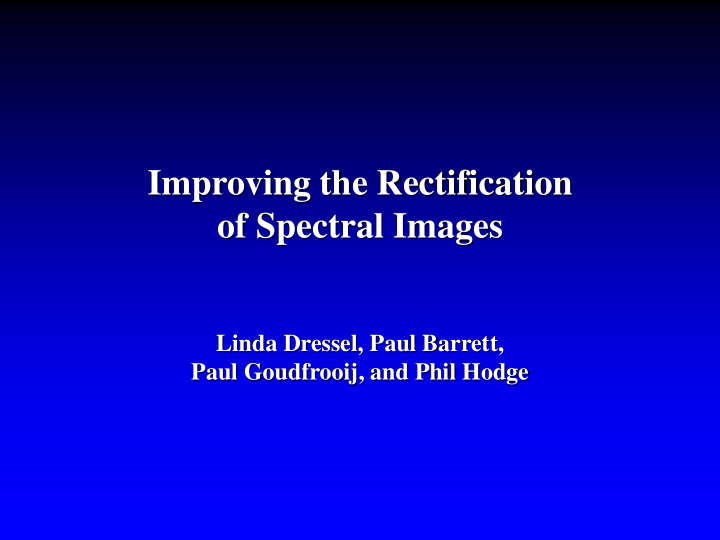



Improving the Rectification of Spectral Images Linda Dressel, Paul Barrett, Paul Goudfrooij, and Phil Hodge
Overview • Accurate spectral traces are especially needed for analysis of single rows in spectral images. • Artifacts are produced during the rectification of spectral images because the traces are tilted slightly across the detector, and the spectrum is undersampled along the slit. • Combining images dithered by a half pixel along the slit substantially reduces the magnitude of the artifacts. • Optimizing the rectification of spectral images involves a trade-off between miminizing the artifacts and preserving spatial resolution.
Spectral traces are slightly tilted across the detector, resulting in artifacts in rectified spectral images. The reference file traces are often significantly incorrect for the analysis of single rows in rectified images.
These are spectral traces for G430L taken over the lifetime of STIS, along with the reference file trace. The tilt of the traces has been evolving steadily over time, showing clockwise rotation on the detector.
The traces for G750M cluster around two different tilts. The reference file trace is similar to the earliest traces. The evolutionary plot shows bimodality super- imposed on clockwise rotation. Either of two traces is possible on a given day.
Adjacent rows in crj images are strongly affected by the tilt of the trace, generally peaking where the spectrum is y-centered on a pixel.
In the peak row of the rectified spectrum, the flux peaks where minimal interpolation occurred. The adjacent rows gain flux where it is lost by interpolation from the peak row. There are many cycles of fluctuations across the spectrum for gratings with the most tilted traces: G230L (~18), G140M (~10), G230M (~16), G430M (~8), G750M (~7). The broad structure in the plot on the right is produced by the error in the tilt of the trace in the reference file. A self-derived trace was used for the plot on the left.
A half-pixel dither along the slit has been used here to provide better sampling in the spatial dimension. The two crj images have been interwoven so that this information can be used in the rectification process.
Peak row Offset +/-0.5 pix Offset +/-1 pix The amplitude of the fluctuations in flux in the rows of the rectified image is greatly reduced.
Peak row Offset +/- 1 pix Here is a comparison of the flux in the peak row and in the rows one pixel away in the rectified images made from single and combined crj images.
Science data often contains a mix of compact and extended flux. Adjacent rows in the crj image can differ greatly, both because of the tilted trace and because of real changes in source structure along the slit. A half-pixel dither along the slit was used to provide the intermediate row shown in the plot on the right.
A row in the rectified image is shown for a single input image (dashed line) and a combined dithered image (solid line). The difference shows fluctuations in the single image produced by a power-law continuum, a broad H alpha component, and a compact blue H alpha wing.
This original rotation curve produced from undithered data is asymmetric. The photometric center is located at the row with the largest error bar, distinctly displaced from the kinematic center.
The dithered image has significant scientific consequences. The symmetry of the rotation curve is consistent with a black hole well centered in a galaxy nucleus surrounded by a simple rotating disk.
Flux profile along the slit for G750M (red points) and G750L (blue points) at 6600 Angstroms. Finely dithered PSFs can be produced by two techniques. For strongly tilted traces, the drop of the trace across the detector acts as a progressive dither. For shallow traces, the slight randomness in the placement of the trace on the detector acts as a dither for a sample of many observations.
Flux profiles are shown for columns where the trace is centered on a row and where it straddles two rows. Wavelet subpixeling is shown for these profiles, before and after convolu- tion with a model PSF. Subpixeling improves the agreement, but it is con- volution that makes the profiles nearly identical.
Here is the peak row in the spectrum of NGC 3998. Black: x2d for combined dither steps Red: x2d for a single undithered image Green: wavelet interpolation without convolution (left) and with convolution (right), and its difference from the x2d for combined dither steps. Wavelet without interpolation is an improvement on the undithered x2d.
Here is the spectrum of the galaxy one row off peak. Black: x2d for combined dither steps Red: x2d for a single undithered image Green: wavelet interpolation without convolution (left) and with convolution (right), and its difference from the x2d for combined dither steps. Wavelet without interpolation is similar to the undithered x2d.
Here is the spectrum of the galaxy two rows off peak. Black: x2d for the combined dither steps Red: x2d for a single undithered image Green: wavelet interpolation without convolution (left) and with convolution (right), and its difference from the x2d for combined dither steps. Wavelet without inter- polation shows stronger artifacts than the undithered x2d.
Peak row One row by off peak Ratios of spectra created from each of the dithered images: Black: x2d Blue: wavelet without convolution (better than x2d in peak row) Red: wavelet with convolution (better than x2d at the expense of resolution)
Conclusions Spectral traces show time evolution that will be incorporated into reference files. We are developing post-pipeline software to generate traces for modes with additional complications. Single rows in rectified images must be used carefully, with a full understanding of the artifacts. Along-the-slit dithering is the most effective way to enhance spatial resolution in spectral images. Wavelet interpolation can be helpful in improving the rectification of spectral images. The impact of spectral artifacts must be weighed against the need for spatial resolution in deciding how to apply it.
Recommend
More recommend